Blue Laced Red Wyandotte: Breed Profile
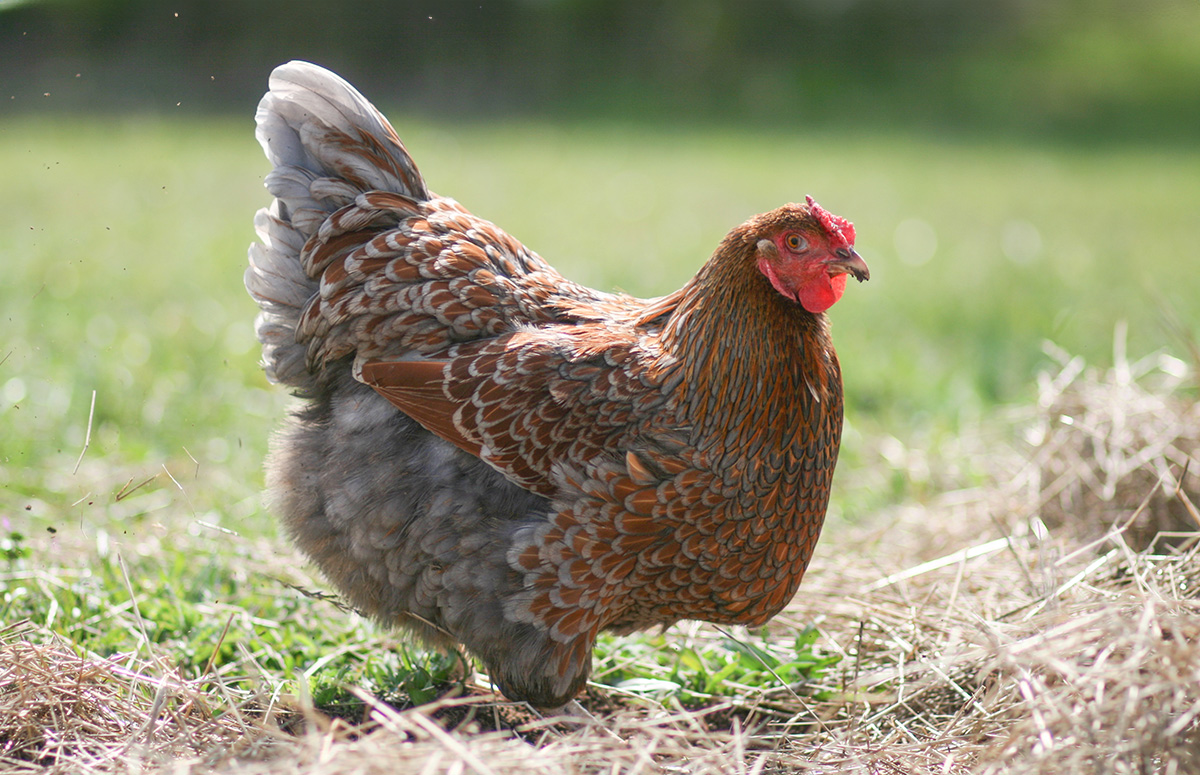
Characteristics | Eggs | Hen vs Rooster | Chicks | Climate | Blue Laced Color Pattern | History | Genetics | Breeding | Blue vs Splash | Personality
The Blue Laced Red Wyandotte is a stunning chicken with unique reddish-brown feathers delicately laced with shades of blueish grey. This color variety of the Wyandotte turns heads, whether you’re new to chickens or a seasoned breeder. Photos of Blue Laced Red Wyandottes are like gold on social media and magnets for likes on Instagram.
Let’s check out what’s so special about this American breed.
| Eggs | 200 eggs/year |
| Egg Color | Brown |
| Egg Size | Large |
| Weight | 6.5 – 8 lbs |
| Hardiness | Cold |
| Temperament | Friendly but dominant |
| Beginner-friendly | Yes |
| Color | Red, Blue Laced |
Characteristics
The Blue Laced Red Wyandotte is a striking variety within the Wyandotte breed. The American Poultry Association does not officially recognize this color variety, but it is the favorite color of many Wyandotte breeders worldwide.
Its name describes its coloration: a beautiful mix of a reddish base plumage with distinctive greyish-blue lacing around each feather. Their unique coloring gives them a regal appearance that stands out in any flock.
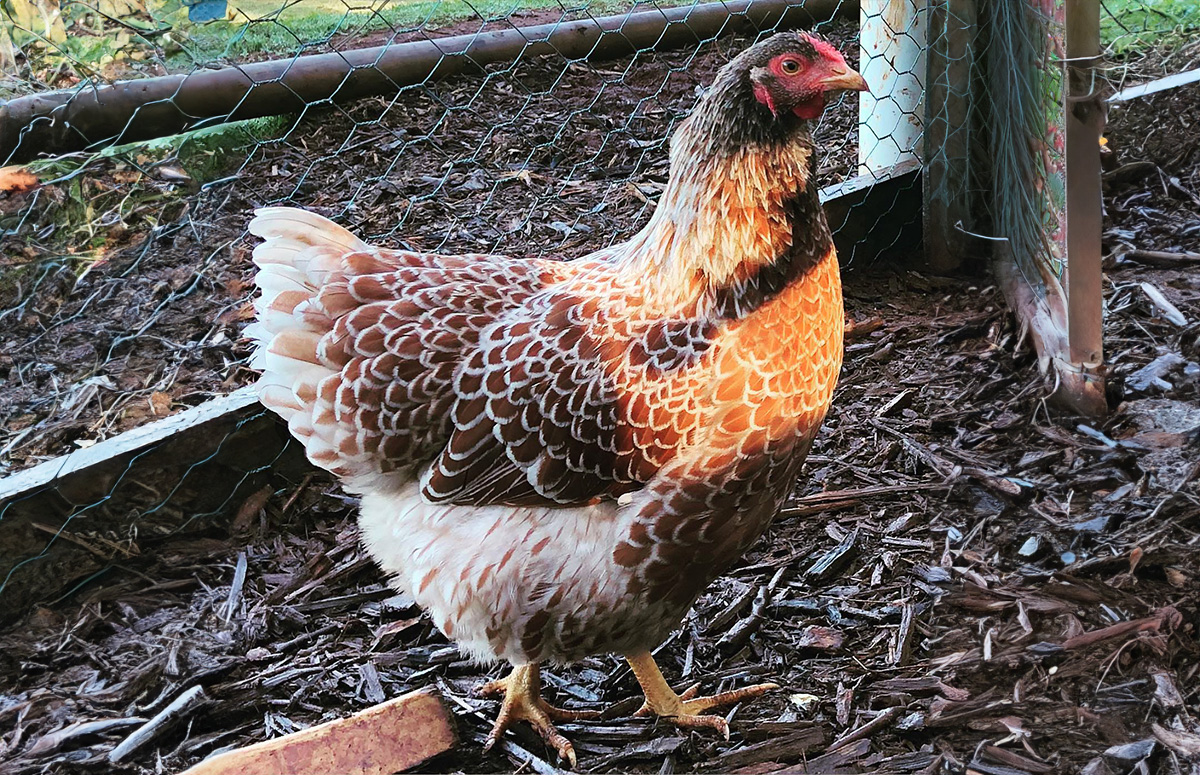
Like the other chickens in the Wyandotte chicken family, the Blue Laced Reds are rather large and have a round body posture. Blue Laced roosters tip the scale at 8 pounds (3,6kg), and Blue Laced hens weigh around 6.5 pounds (2,9kg).
Blue Laced Red Wyandottes have a red rose comb, and their legs are clean and yellow-skinned. The wattles and earlobes are red. Their beaks are dark golden, complemented by yellow eyes.
In line with the Wyandotte breed’s characteristics, they possess well-developed, round breasts, making them a superb choice for both meat production and egg laying capabilities.
Eggs
Blue Laced Red Wyandotte hens are great egg layers and lay around 200 medium to large brown eggs every year. They are dual-purpose chickens, appreciated for both their meat and egg-laying capabilities.
In the winter, they usually slow down or stop laying, but if you add some extra light, these cold-hardy birds tend to keep laying eggs. The only time Blue Laced Wyandottes stop laying eggs is during molting, which happens each year around late summer or early fall.
These chickens are also likely to go broody occasionally, which is great news if you plan to hatch eggs. But keep in mind that egg production will temporarily stop during broodiness.
Blue Laced Red Wyandotte Hen vs Rooster
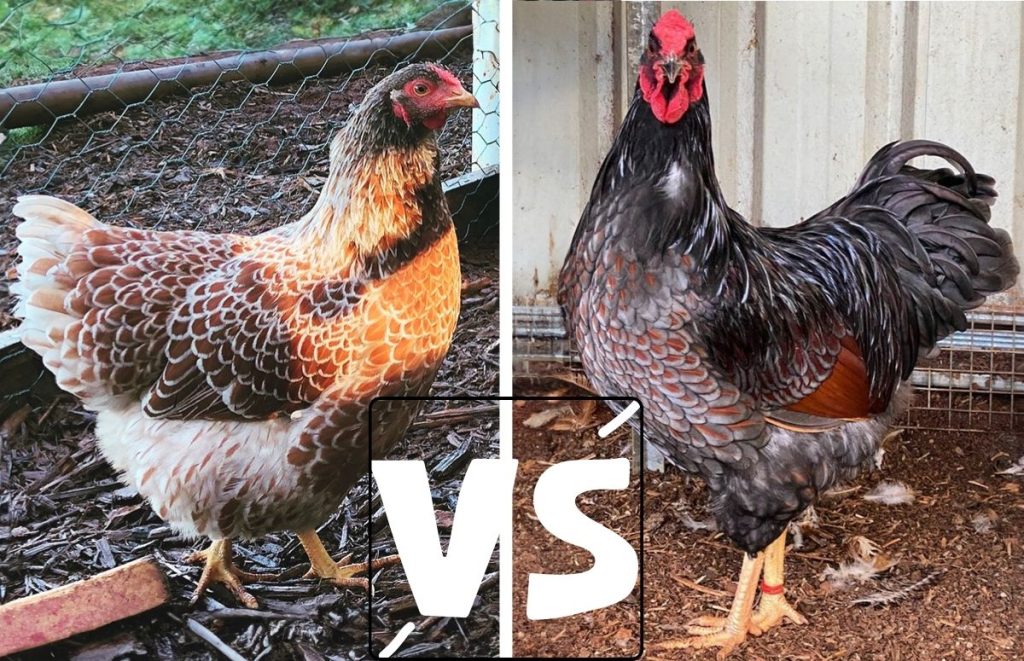
Both Blue Laced Red hens and roosters have beautiful reddish-brown plumage with greyish-blue lacing. They share several features, such as the dark brown to grey head, brown undercolor, and blue lacing. It can be challenging to tell the boys from the girls in young birds.
However, roosters are usually darker in color than hens. They have dark grey sickle feathers and hackles, while the females are light brown to brown. The tail feathers of the hens are light brown to light grey.
| Feature | Blue Laced Red Rooster | Blue Laced Red Hen |
|---|---|---|
| Weight | 8 lbs | 6.5 lbs |
| Back | Pointed saddle feathers | Rounded feathers |
| Plumage | Patchy (cockerels) | Uniform lacing (pullets) |
| Tail Feathers | Long sickles, pointed, no lacing | Laced, shorter, rounded on the edges |
| Tail Coverts | Dark grey, almost black | Light brown to light blue |
| Comb, Wattles | Big, red | Small, pink |
| Body | Broad, long legs | Smaller, shorter legs |
Young cockerels don’t have a pronounced plumage and can look patchy. Pullets have a pretty uniform lacing.
Sometimes, the birds can take a while to develop certain traits. Some pullets turn out to be cockerels, and the other way around. You can definitively determine the gender in Blue Laced Red Wyandottes by the age of 5 months.
Chicks
Blue Laced Red Wyandotte chicks can have various patterns in their down. Some are light brown, while others will be yellow. Most chicks will have a greyish sheen or patches in their down or will be almost completely grey.
When the birds start feathering out, their feathers can look black at first, almost like black laced gold. But when the feathers grow, you can see the blue pattern appearing of the Blue Laced Red.
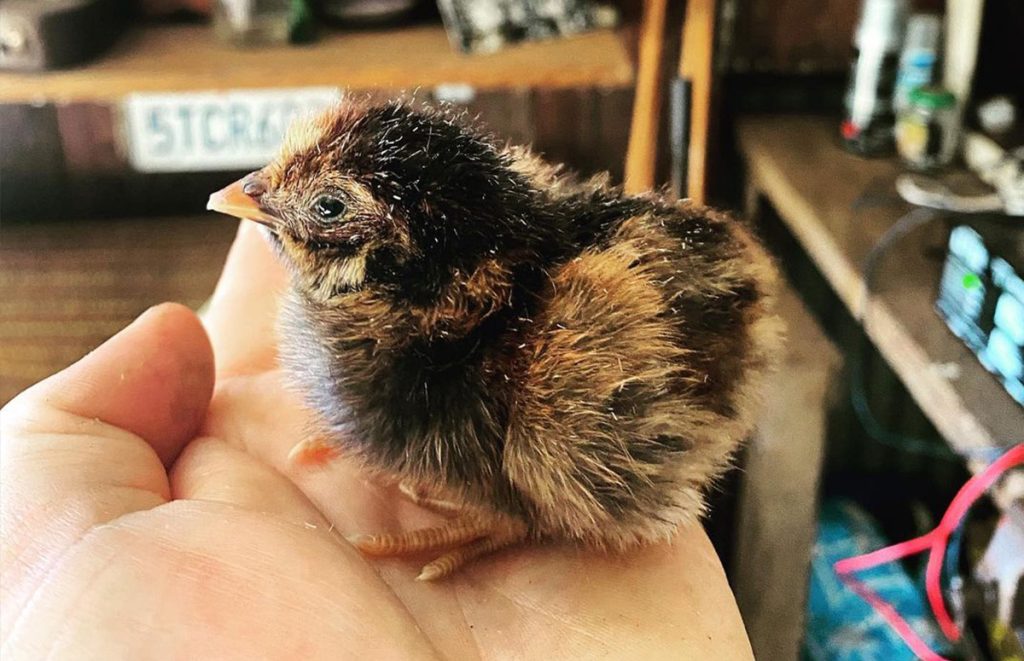
Blue Laced Red Wyandotte chicks are not sex-linked, so you can’t tell whether they are female or male after hatching. It takes a couple of months to identify the gender. The cockerels generally look more patchy when they grow up, while the pullets have a uniform pattern.
In general, Wyandotte hens are excellent mothers for their chicks.
Climate
Blue Laced Red Wyandotte chickens are a hardy and adaptable breed, making them suitable for cold climates. Wyandottes have especially been bred since 1870 to stand cold American winters.
Their rose combs, which are low and broad, are much less susceptible to frostbite than single combs, and their dense feathering helps to keep them warm during colder winters.
On the flip side, Blue Laced Red Wyandottes aren’t too keen on tropical temperatures.
So, during a heat wave, always keep them cool. Otherwise, they’ll quickly overheat and suffer heat stress.
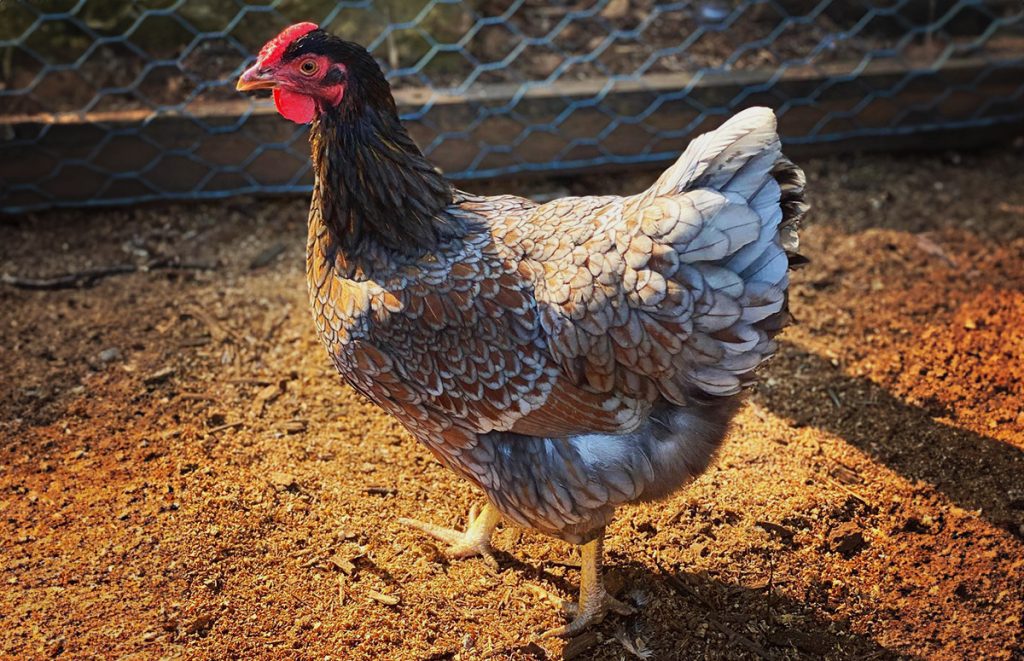
The Blue Laced Red Color Variety
The Blue Laced Red variety is one of the many color varieties of Wyandottes. It’s not yet an officially recognized color by the American Poultry Association, but it’s recognized in British and European Poultry Standards and can be shown in exhibitions.
The world of Wyandotte chicken colors can be a complex maze to navigate. While The Standard of the American Poultry Association recognizes only ten official varieties, the Europeans list thirty colors, including the Blue Laced Red. Let’s see how it stacks up against the other variations.
The Wyandotte chickens generally come in three classes:
- Laced Wyandottes: silver laced, gold laced, blue laced, …
- Marked Wyandottes: black-white Columbia, Silver Pencilled, …
- Single-colored Wyandottes: white, blue, black, buff, …
The Silver Laced Wyandotte is the original color variety. It’s a pure white bird with a black edge to its feathers. A Gold Laced Wyandotte is a gold bird with black lacing. The hens are mahogany brown.
If the Silver Laced is white and the Golden Laced is brown, you might think the Blue Laced is blue (grey). However, the Blue Laced Wyandotte does not have a greyish body. Only their lacing is blue, and Blue Laced Wyandotts can have many base plumage colors, like red or silver.
For example, the Blue Laced Silver Wyandotte is similar to the Silver Laced Wyandotte, but the lacing is greyish blue rather than black.
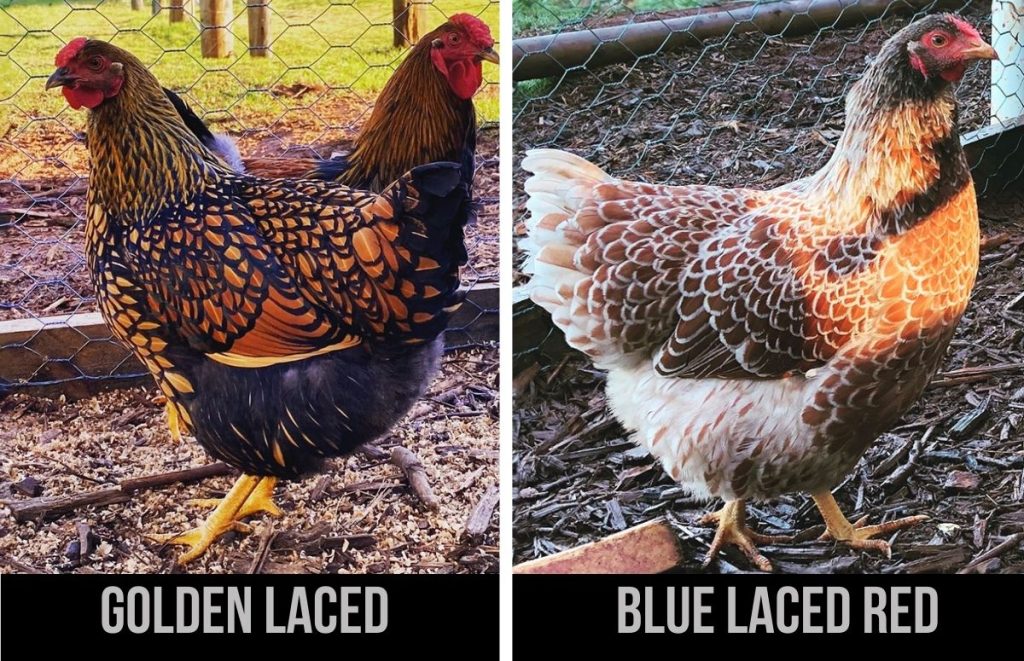
Finally, the Blue Laced Red Wyandotte looks similar to the Golden Laced Wyandotte, but its lacing is greyish blue instead of black, and the birds have a (double) dose of Mahogany that makes them red.
History of the Blue Laced Red Wyandotte
The Wyandotte chicken was created in the United States during the 1870s by four breeders: H. M. Doubleday, John Ray, L. Whittaker, and Fred Houdlette. The Silver Laced Wyandotte was the first official color variation, gaining recognition in the American Standard of Perfection in 1883.
The origin of the Wyandotte remains a mystery, but according to Livestock Conservancy, it is believed to result from breeding efforts involving spangled Hamburgs and dark Brahmas.
After that, many varieties, including the Golden Laced and Blue Laced, were created.
The Buff Laced and Blue Laced varieties were first observed around 1897, emerging from the crossings of Gold Laced and White Wyandottes. The blue is comparable to the blue in the Blue Andalusian.
As mentioned, the Blue Laced variety is not yet officially recognized in the US but is an official color in the UK and Europe.
Blue Laced Red Wyandotte Genetics
Basically, the Blue Laced Red pattern in Wyandottes is the result of two effects:
- the brown to mahogany red ground color
- the greyish blue lacing
We’ll discuss them one by one.
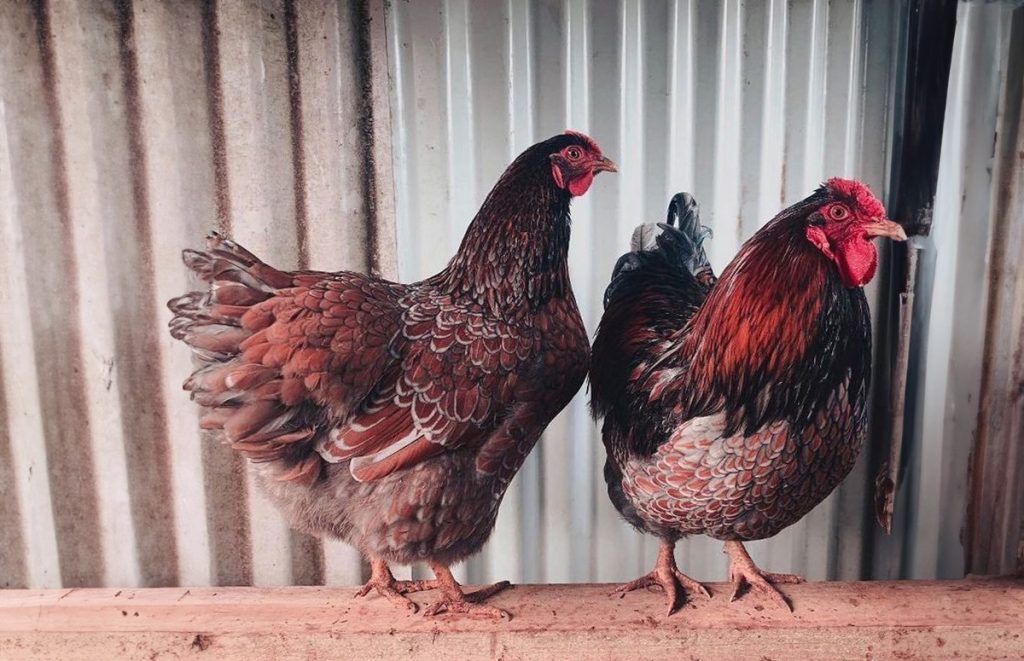
Red Color
The ideal ground color varies. The British Standards for Blue Laced Red Wyandottes demand red-brown, while the Dutch ideals are gold-brown. Yellow to brown is the natural wild type for the color of chickens. This color comes from pheomelanin pigments in the feathers (the same pigment that makes our human lips red).
Red boosters can enhance this brown ground color. The most well-known example is the mahogany red of the Rhode Island Red.
The most important red enhancer gene for Wyandottes is Mahogany (Mh). It’s a dominant gene, so birds with a single copy (Mh/mh+) will show dark red. Some breeders will tell you that birds with a double dose of mahogany will have a darker tone, but there is no consensus for that.
Blue Lacing Genetics
The lacing pattern results from the interplay of multiple genes that shift the black pigment in the feather. The pattern gene (Pg) creates several lines, the Melanotic gene (Mg) shifts them to the rim, and the Columbian gene (Co) removes the inner laces.
The greyish color of the lacing comes from the Blue gene, which dilutes the black pigments in the feather. Chickens that have a single copy of the Blue gene (Bl bl+) look greyish. Birds with two copies (Bl Bl) look Splash or almost white.
The Blue Laced Red Wyandotte has only one copy of the Blue gene, while the Splash Laced Red Wyandotte has two. The Golden Laced Wyandotte has no blue gene (bl+ bl+), which results in black lacing.
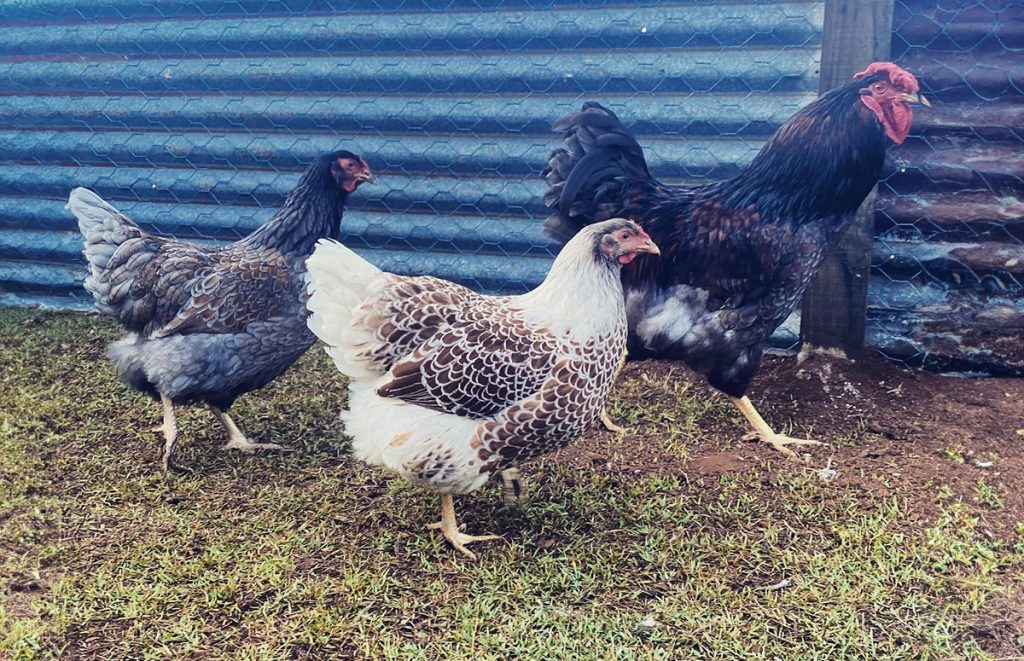
Blue Laced Red Wyandotte Breeding
Blue Laced Red Wyandottes are the most difficult to breed of all laced Wyandotte color varieties. Breeding laced Wyandottes is already a challenge on its own. It’s difficult to get a uniform and beautiful lacing around the inner field of the feather.
The first challenge for Blue Laced Reds is to balance the red ground color. Too light and an unwanted grain appears; too dark kills the overall appearance.
The second challenge is that Blue Laced Reds don’t breed true, unlike other color varieties in the Wyandotte chicken, like the Silver Laced. If you cross two Blue Laced Red Wyandottes, you get 25% Black Laced Wyandottes, 50% Blue Laced Wyandottes, and 25% Splash Laced Wyandottes.
| Parent 1 | Parent 2 | Offspring |
|---|---|---|
| Blue | Blue | 50% Blue, 25% Black, 25% Splash |
| Blue | Black | 50% Blue, 50% Black |
| Black | Black | 100% Black |
| Blue | Splash | 50% Blue, 50% Splash |
| Black | Splash | 100% Blue |
| Splash | Splash | 100% Splash |
If you want to breed chicks for sale and guarantee they are all blue, mate black-laced with splash-laced. Every chick from this cross will be blue-laced.
These breeding outcomes illustrate the complexity of these various lacing colors. The preference for blue or splash lacing is a matter of personal taste, and breeders work with specific crosses to achieve their desired results.
Blue Laced Wyandotte vs Splash Laced Wyandotte
The key difference between blue and splash lacing in Wyandottes lies in the color of the lacing. Blue lacing is a more vibrant gray or violet, while splash lacing is pale gray or almost white.
Blue is more sought after. The Splash Laced birds usually have a lot of white in their hackles, at the end of their tails, and on their legs. Some birds are stunning, but several birds look rather patchy.
In this photo you can see the a nice splash hen with very white lacing and a lot of mahogany red in the feather. Next to it is a blue laced wyandotte rooster and hen. Although it’s only a single copy of the blue gene that sets them apart, it’s a major difference in their overal presence.
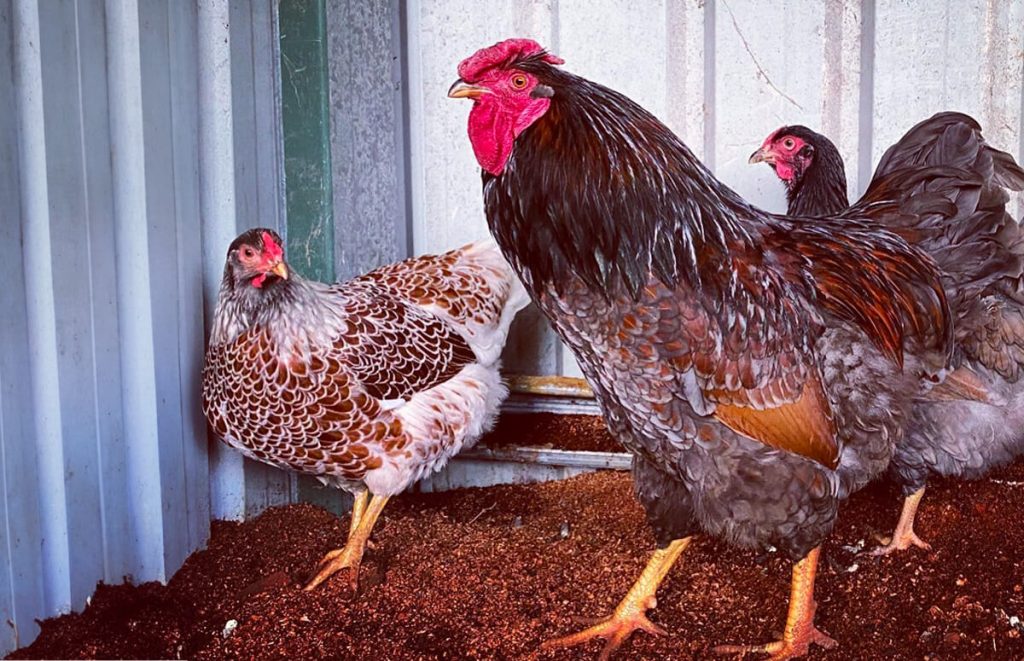
As discussed in the blue laced wyandotte genetics section above, the blue gene is codominant; flocks with Blue-Laced Reds will always have some Splash Laced and Black Laced birds when they start mating and crossing.
Personality
Blue Laced Red Wyandottes are typically gentle and friendly like all Wyandotte chickens. They show kindness towards humans and children, though their size might make them less suitable lap chickens.
They are sociable and often enjoy human interaction, making them a popular choice for those who want a more personable backyard bird.
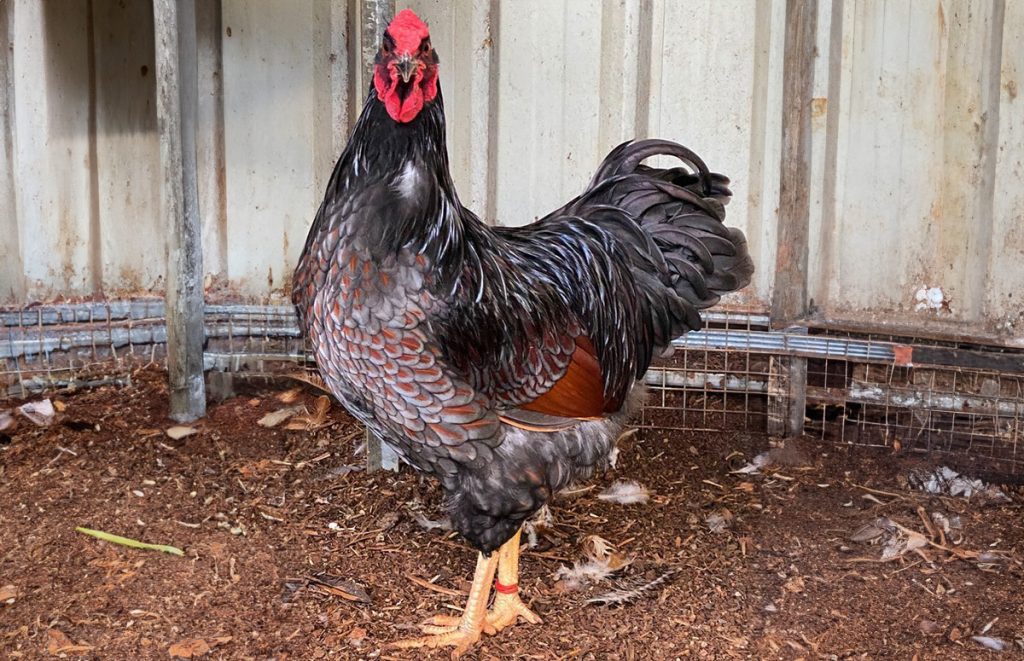
They generally get along well with other flock members, but it’s worth noting that the roosters can occasionally display dominant behavior. Due to their assertive nature and slightly heavier build, Wyandottes are mostly positioned high in the pecking order.
Related Articles
Here are some of the articles we mentioned:
- Wyandotte Chickens: an overview of the Wyandotte chicken breed and the color varieties
- Silver Laced Wyandotte: a breed profile of the Silver Wyandotte variety
- Silver Penciled Wyandotte: a breed profile of the Silver Penciled Wyandotte variety
- Golden Laced Wyandotte: a breed profile of the Golden Laced Wyandotte variety
- Buff Wyandotte: a complete guide of the Buff Wyandotte chicken and buff varieties
- Blue Wyandotte: a complete guide of the Blue Wyandotte chicken and blue varieties
- Splash Laced Red Wyandotte: a guide on the Splash Laced Red variety
- Columbian Wyandotte: a striking black and white variety of the Wyandotte chicken
- White Wyandotte: a breed profile of the White Wyandotte
- Sebright Chickens: a chicken breed that has varieties with a similar lacing pattern
- Brahma Chickens: large chicken breed originally used to create the Wyandotte
- Hamburg Chickens: chicken breed used to create the Wyandotte, with similar black and white patterns
- Chicken Feather Guide: to understand the difference between all types of feathers
- Chicken Breeding & Genetics: an overview for chicken breeding and genetics for beginners
If you are considering to get Silver Laced Wyandottes, here are some other resources:
- Chicken Coop Size Calculator: to calculate the size of your coop
- Chicken Raising Guide: general chicken raising guide
Credits for the photos and special thanks go to Cactus Hill Poultry breeders, specializing in breeding Wyandottes.






















